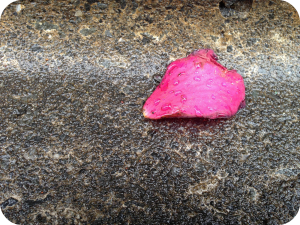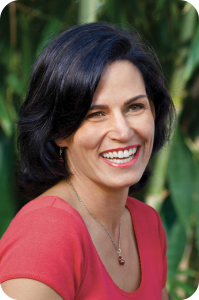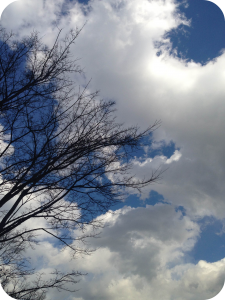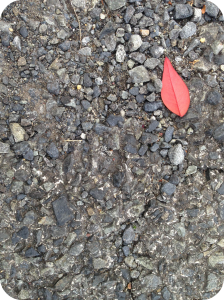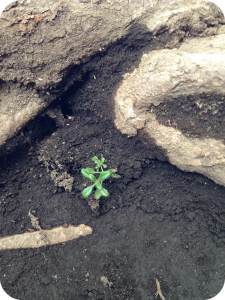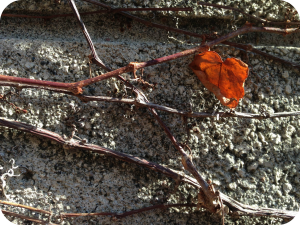“What’s this, Mama?” My two-year-old daughter kneels and points at the base of a tree, her eyes intent and curious.
It’s an overcast autumn morning soon after a rain. The hollows in the flagstones lining the wide walkway into the park stand pooled with water, and fallen leaves litter the whole area. A few sparrows hop and peck a short distance away, paying us no mind.
I crouch next to her and look more closely. “It’s moss,” I say. “See how it’s nestled in here all snug on the tree?”
“Why?” she asks.
“I’m not sure, actually. I guess it makes a good home for the moss, and maybe it’s good for the tree too,” I say.
She reaches out a finger and touches it, tentatively at first, ready to pull away at any second. Instead she gasps with delight. “It’s soft,” she says. “And wet.”
“Yeah, it is, huh? You can touch it as much as you want if you’re gentle.”
Her three-year-old brother runs up behind us, holding a stick in one hand and several yellow leaves in the other. “What are you guys looking at?” he asks.
I wait for her to answer him but her attention is entirely focused on the moss; she doesn’t even seem to notice he’s there. She sits back on her heels now, studying it.
“See this moss here?” I say, pointing. “We’re just exploring it a bit.”
He crouches beside his sister, the sleeves of their coats touching. I watch them for a moment, their eyes open wide with interest. An unusual quiet settles over the whole area.
He tilts his head to the side and bends low, his face close to the moss. “It’s really bumpy,” he says. “Like grass, but smaller.”
Mimicking him, she tilts and bends to the opposite side. She reaches out her hand again, palm flat this time, and begins to stroke it gently, lovingly, as if it’s a small animal. He does the same, and a shiver of enjoyment runs visibly through his body. They smile at each other and start to laugh, taking turns stroking it and sitting back just to look at it.
“We could dig this up, Mama,” he says, “and take it home with us.”
“We could,” I say, “but see how it lives so closely with the tree? We wouldn’t want to hurt the moss or the tree by trying to dig it up, right?”
He shakes his head in agreement. Then his face brightens. “We can come back and visit it!”
“Sure we can,” I say. “Whenever you want. It might look different each time, too. We could watch for its changes.”
She’s been quiet a long time, ruminating. “I wanna take a picture of it,” she says suddenly.
“Me too! Me too!” he says, jumping up and down.
I take out my phone and we huddle in close around the bright screen, each of them taking dozens of blurry but fond pictures of their newest happy discovery.
I turn away from my empty bedroom, having just given it the final once-over. All the scattered belongings I’d nearly forgotten have been tossed into a spare shopping bag by one of my housemates, and it bulges so that I can scarcely hold the handles together. I glance down and notice a shoe lying across the top; the younger of their two dogs has enthusiastically chewed large holes into its toe.
For reasons I don’t entirely understand, things are not coming to an amicable end in this house where I’ve lived for the past couple of years. My chest aches with the urge to repair the relationship somehow, and with the apprehension that I probably never will.
My now-former housemate stands near the front door, one arm horizontal across her chest, my key dangling from her finger. The false cheerfulness of her demeanor forms a slick veneer over the tension in her body.
The elder of the dogs runs to me, toenails clicking and skittering on the hardwood floor. He has brown patches above his eyes like eyebrows, and they slant with concern. I kneel and bury my nose in the fur at the back of his neck, stroking the tender openness of his throat. His scent has the musty tang of an older dog and, at the same time, is just his very own. Hanging low between his legs, his tail wags cautiously with restrained pleasure. I stand and kiss him between his eyes, still oblique with worry, and gently tug his ears through my hands just the way he likes.
I think of the many nights these two dogs spent in my bed, gradually unfolding their bodies hour by hour until eventually I lay teetering on the edge of the mattress, a forepaw or two grazing my face.
The younger dog bounds toward me then, her tail whipping back and forth as she barrels ahead. Her feet lift and fall in a dance of excitement, and she thrusts her head between my knees—her preferred position for receiving affection. I scratch the spot just above her tail and she wiggles eagerly, fully receptive and brimming with zeal.
Her nose bumps the leashes hanging behind me and her whole hindquarters waggle expectantly. “Not today, sweetheart,” I say, backing up to rub her ears. “Maybe sometime soon.”
I flash a glimpse up at my housemate. She half-smiles but her eyes dart immediately away. My throat tightens and I return my gaze to the dogs.
Outside I climb into the car, eyes welling up, and look over at the friend who’s been waiting for me here.
“You OK?” she asks.
“I’ll be all right, thanks,” I say, turning back for a last look at the house.
As usual, both dogs stand alert on the couch, peering out at me as I leave. In perfect synchronicity, their two heads follow the car as it slowly pulls out into the street, drawing me away one last time.
We’ve all been there.
Every single one of us has had the experience of sitting in front of a project we need or want to be doing with that chest-constrictingly painful feeling of blockage. There’s a tightness, a restriction, an obstruction taking place, resulting in the inability to eke out even the tineest dribble of satisfying work.
And we’ve all been on the other side too—of the spirit-lifting joy that comes with riding a wave of creativity. We might be just going about our business when this feeling arises, but more likely we’re plugging away at our usual work when something seems to lift us from below and carry us along with it. It’s a wonder and a delight, to be sure, and it’s how most of us imagine creative work should ideally look.
But if these are two ends of a spectrum, in between them lies the wide range of experience where we most often fall. We can tilt more toward one end or another at different times in our lives, depending on our circumstances. And, of course, the most powerful and influential of these circumstances is what’s going on in our minds.
During times of resistance to our creative work, we’re often stopped by fear, procrastination or just plain inertia. There are tools to help get beyond these issues, of course, but much of the time we may not even realize we feel blocked. We tell ourselves that we’re busy or we’re tired or we’ll do it when things settle down. But in the meantime weeks or months or even years may pass by without the right time ever coming along.
And when that happens it’s time to delve deeper. What’s at the root of the story? What are the repetitive, mantra-like—possibly even unconscious—thoughts which hold you back from the work you’d most like to do?
Because thoughts are very often the beginning of behavior, a shift in thought can often make a dramatic impact. When your thoughts are in harmony with the greater needs of your whole self, you’re free to respond openly, genuinely, respectfully to the creative urges you feel.
After all, our most meaningful and impactful creative work comes from that place of wholeness. It’s only when we’re able to lean into the dance of wholeness—of the natural integration of our minds, bodies, emotions and spirits—that the work will flow in the way we most yearn for.
The most important aspect of any of this is, as ever, attention. Attention to your thoughts, feelings and urges will help guide you in all that you do, but is absolutely vital when it comes to creative work. What pulls you? What wants to be done, said, sung, painted, danced? In what way are you comfortable letting it move through you? What small thing could you do today that would feel good, fun, revitalizing?
Because the way to cultivate any lasting habit is make it feel good. Where’s the pleasure? Find that and you’re well on your way.
Five of us sit around the slightly cramped table, sunlight pouring into our 19th-floor office and glinting off the blue-green glass of a neighboring skyscraper.
The rough drawings for 24 different children’s storybooks lay in front of us, and one by one we examine them, making corrections, scribbling suggestions, marking changes. The stories shift slowly before our eyes as we hone them—paring sentences, noting ways the images might be improved, bouncing out propositions for more interesting compositions.
Together we explore ideas for how to teach and entertain our audience—Japanese kids learning English—as well as how to engage them. Wherever possible we work to bring the language alive for them so that they might learn more of it, maybe even grow to love it. The piles of paper grow fatter as we turn the pages and add our notes, and the smells of ink and coffee mix and thicken around us.
We get better and better at this as the morning progresses, sinking into the enjoyment of being there with our little stories—many of which we’ve written ourselves. Tweaking each one word by word, we grow ever more gratified as we find clever ways to sneak in additional vocabulary from our carefully-crafted syllabi.
There is an art to this, to be sure, and it’s a joy to find ways we can make the work both flowing and functional, shaping it to suit the needs of students and teachers alike. Within our narrow parameters, we strive to keep the language accessible while also allowing the stories themselves to take life.
The excitement of watching these short narratives grow clearer as we ourselves shape them has us caught up in it, and there in an office that can often feel dull and oppressive, we’re buoyant, ebullient. Our work lays spread out on the table, covered in notes, soaking not just in the pool of the ever-shifting sunlight, but in the expanding light of our own enthusiasm for it.
After a while we take a little break, needing to stretch and move. A coworker and I go to the ladies’ room, where we sometimes go to grouse. There in front of one of the mirrors gently lit by the open blue sky, she stands watching herself expertly re-apply her lipstick. I lean against the narrow counter, watching too.
We’re rarely silent like this, she and I, but in that moment I’m still slightly intoxicated by the experience we’ve just had—by the sense of our work coming together, of things moving in exactly the way they should, of the rhythm we all effortlessly followed in a smooth yet unchoreographed dance.
“You know,” I say, meeting her eyes in the mirror, “when this job is fun, it’s, like, really fun.”
Her eyes are sharp on mine as she caps her lipstick. Wordlessly, she gives me the wry smile I’ve come to know so well and walks out ahead of me, back to the work we’re here to do.
Whether they come through a tightening in the chest, a flicker of unease in the stomach, or an expressive lifting of the cheeks, we’re all intimately familiar with the ways emotions move in and through our bodies.
Some pass continually through us, day after day, and we let them go easily. Mild annoyances or small pleasures often move through unimpeded and don’t make much impact.
But others, in contrast, become stuck in our bodies, stuffed down once and piled upon ever after. Though when they arise these emotions might seem connected to a unique situation in our lives, many of them are actually touching on old thoughts and ideas that lay deeply buried within us.
Because emotions often originate from a belief. Imagine, for example, that you’re at work and feeling a little hungry. You remember the apple you brought today, and start to think about it, anticipating its texture, its taste. But when you go to the kitchen and open the fridge, the spot where you’d left your apple is vacant. A peek in the garbage can reveals the remains of your apple chomped tidily down to its core.
The situation is thus: someone has eaten your apple. That’s the only factual information you have at this moment. Who has done it or what their motives are remain wholly unknown to you. Any ideas, and thus emotions, that arise right now are connected to the thoughts and beliefs that were already there when you placed the apple in the fridge this morning.
For some of us, this might elicit no real emotion at all. Someone ate your apple? Not a big deal. You can get another apple, or grab something else. Whatever annoyance or frustration comes up might move right on through without any obstruction.
But for others, what might on the surface seem like not such a big deal can trigger ideas or beliefs that are not necessarily even conscious. “No one respects me,” maybe, or “Nobody cares about me.” It could be anything, really, but whatever gets touched by this experience catalyzes an emotional response. Particularly if the response feels out of proportion to the specific event, the emotion is there as a messenger with something to share.
It may express as anger, fear, or even shame. Whatever that emotion is, the trick is to bring awareness to it. Rather than reacting immediately–fishing the core out of the garbage and dangling it accusingly in the face of the most likely suspect, for example–you could choose instead to respond to the situation within yourself.
Pause. Breathe. Notice your body. Where is there tension? When you pay attention to that sensation, what happens?
The truth is that all our emotions require of us is our presence and our awareness. They’re asking to be heard. When we honor them with our attention, they can in turn honor us with the deep and important messages they bear.
Breathe. Listen. Where’s the gift? Because there undoubtedly is one there for the taking.
When I discovered Denise LaBarre’s book “Issues in Your Tissues,” it struck me immediately as exactly the bodywork book I’d been looking for. Through keenly observed stories of her own work with clients, Denise delves into the body-mind-emotion connection and then provides practical, easy-to-implement ideas for how to strengthen that connection and come home to the body. Denise was kind enough to sit down with me for a lively and in-depth conversation about her work and her book.
You have a fascinating and lengthy history with bodywork. What brought you to write “Issues in Your Tissues”?
Well, I’m a writer and words are my medium. And I noticed I was saying the same things to clients regardless of their age, education, even their level of health and fitness. Everyone who wound up on my table needed to open their breath. Everyone had lost at least partial connection with the wisdom in their bodies, and I realized I wanted to reach a broader audience than I could reach with just my hands through individual work.
Did you find that when you would talk to people about these things that there was a range of reactions in terms of how ready people were to hear it? What was your general experience with that?
There’s a huge range of their readiness, and what’s neat about working with individuals is that I can feel their body, I can feel their breath. I can watch and steer what I say to their receptivity. And I can get them physically breathing so there’s this huge opening to a different kind of receptivity. Our right brain receptivity is vast, but most of the time we’re in that logical, reasoning place that wants logical answers, and healing is not in the logical place.
What’s your conception of the mind-body-emotion-spirit connection, and how did it inform the writing of your book?
We talk a lot about the mind-body connection but I haven’t seen a lot of places where people add emotions in, and it was one of the things I wanted to do with my work and the book. Because our entire society is geared toward being rational, being productive. We don’t breathe, we don’t feel. This is changing, but emotion is that link to all of that richness, and it’s socialized out of us so early.
So talking about emotion is important, and even more important is getting people comfortable feeling their anger, their sadness, their grief. When we’re able to experience our emotions we can move on from them rather than lugging them around as baggage.
So do you think that not feeling the emotions directly is what causes them to get stuck in our tissues?
Yeah, absolutely. If you feel something that makes you angry, it’s often felt as heat–just a pure energy running through you. If you allow the energy to run through you, it takes a couple of seconds, if that.
The resistance starts early. If you’re taught to constrict the way you naturally feel and experience emotion, as an adult you can be restricted on, say, the anger wavelength or the sadness wavelength.
It’s mainly part of the mind, then, this training that we get? It’s trained into the mind?
I think for example if a little kid is being bullied or abused in some way, especially if it’s coming from a parent or someone they love, there are conflicting emotions. They can become like a glob that’s too big to digest so it just all gets stuffed down. And it’s true that that’s too big a thing to digest for a little kid, but as an adult, that glob is somehow still in there and is added to over the years.
In the book you share many stories of clients you’ve worked with and how their outlook affects their physical bodies. How do our thinking patterns relate to our emotions and the way they’re stored in the body?
Well, imagine a little boy who’s told that if a person feels sadness he’s not a real man, or if he cries he’s not a real man. This little boy will have feelings of sadness or loss or tenderness or joy but he can’t express them, so there’s conflict and he makes a choice.
The energy gets stifled. It gets literally held, and it accumulates. Sometimes you can see someone who’s maybe been angry for a long time and they take up kickboxing or something similar, and some of that energy gets expelled in the course of movement. Or in yoga you can see people getting into certain poses where energy starts flowing, and a release occurs. The energy just needs to be allowed to flow.
And it’s a beautiful experience when it can, and when you feel that release. It’s amazing.
Yeah, and it’s a funny thing: when you’re in that state of releasing there’s no judgment, there’s no, “This is good or bad.” It just is. And it can be intense but it’s often a mixture of pain and joy and all of it. It’s just being.
You write, “One of life’s challenges is to recognize and relearn your own inner language, and to follow your body’s whisperings to improve your health.” How have we disconnected from this inner language, and what’s the first step we can take toward re-establishing that connection?
We disconnected early, and it’s a gradual process along the way. Most people are not completely disconnected. They’re disconnected in some ways but not others, perhaps. There are some people who can laugh really well but may not be able to cry easily.
The first step to re-establishing the connection is to notice that you feel out of sync or out of balance. You might feel something’s missing and reach out in curiosity to see what that might be. The vehicle that I know works is breath. If you have this feeling that something is missing or there’s an intuitive knowing that you could be a lot more joyful or relaxed, it can manifest in really tangible ways, like your skin erupting, or pressure.
That’s your body saying, “You need to reset.” It’s easier to notice these things before they erupt. To re-establish that connection, notice what’s going on. Ask yourself and listen to your body, listen to the aches or pains, feel the tension between the shoulders and start by going inside with breath. Notice what’s going on below your neck. It’s a tuning inward rather than tuning outward, which happens in meditation, and happens in any of the practices that bring us inward.
In one of the stories you share, you advise a client to give himself permission to do the things he feels drawn to do, which some people might see as something they can’t afford to try. How and why is it important to give ourselves permission to follow our internal compass?
First I would ask someone to challenge the assumption that they can’t afford to try, if that’s their assumption. If you’re asking the question, “How can I afford to relax?” that question right there is a good indication that you need to relax.
It’s important to give ourselves permission to follow our inner compass because that’s our most reliable guide in this life. We can see how our minds play tricks on us. They’re always trying to maneuver and position us according to what’s going on outside, according to what seems important to our survival. The mind wants to maintain control. Our internal compass doesn’t lie, and I think we know that.
The mind is steering us toward that tribal fitting in that you were talking about earlier.
The tribal fitting in is there for a reason; we do need to be able to work together. And as adults you come back around full circle to realizing that socialization has its place but you need to re-gather, reconnect with that compass and that internal knowing, and as you do so that’s when you come to wholeness.
At one point in the book you write, “Emotional pain and physical pain are part of the same continuum.” Could you elaborate on that for us?
Pain is an interpretation of a sensation or an awareness, whether it’s physical or emotional. The physical body and the emotional body are vibrations and manifestations on the same continuum. Thought becomes an emotion, which becomes physical.
So the continuum is almost like sediment falling out of a solution. The energy is fluid and we experience it in the human body as a flow. It’s almost as if you sprinkle a thought into a cup of water, it’s the particle that settles down through the fluid of our emotions into the bottom of the glass, which is our physical body.
I was very interested in the way you wrote about surrender in the book. Could you speak to the role surrender plays in healing?
First I’d like to clarify that by surrender I mean letting go, not dropping all your defenses and giving up. When we clench, nothing else can happen. As long as your fists are closed, they’re not open to receive.
Surrender is allowing what is in you, what you are, to come forward and express itself. And if you’re not judging it, not clamping it down, then it is what it is. It’s not that there’s no pain but there’s no residue, no backlash. It just moves through. Healing is an allowing, which is a surrender.
Also, the mind has to surrender, because it’s the mind that wants to control things and is trying to keep you safe. And the best way I know to unlearn that is to practice. Feel some chunk of emotion that has felt scary, perhaps with help from a healer or an advocate, and realize that you won’t die. It’s like something that has to pass through your system–it’s better out.
It sounds like what you’re saying is that in order to do that, we need to feel safe.
Absolutely. Safety is the primary thing that needs to be established when I’m doing private sessions. And a lot of us didn’t have safe boundaries held for us when we were children, and a lot of times society doesn’t hold safe boundaries for us. Trusting your own internal compass is something that ideally you develop in childhood, and if you didn’t develop that trust then, it’s part of your work as an adult in order to come to wholeness.
Yeah, beautiful. So is there anything else you’d like to add before we close?
This process of coming to wholeness is a journey. You can’t know where you’re going to go until you’ve taken a few steps. Trust is one of the biggest components of this journey and it develops as you go. It’s like developing your muscles as you walk. And I think if you set your compass on trust and be gentle with yourself, that’s a good start.
And, of course, physically, take a breath.
I do recommend my book, and that people buy or download the book and start reading. Start with laughing at the cartoons, start with play. Play is an important component in all of our work here as humans, and adults as a whole definitely don’t play as much they could.
Find Denise online at Healing Catalyst, on Facebook, and on Twitter.
Portland, Oregon / Spring, 2002
“How’s this pressure?” I asked, pushing my forearm into the long muscles of Linda’s upper thigh.
“Perfect,” she said, turning her head to the side in the face cradle. “You can continue that way up into my hips.”
Linda was a favorite of mine, as far as regular clients went. She came to me for bodywork about once a week, and we generally chatted amiably throughout our sessions.
After working the tissues in her hips and feeling some release, I began to rock Linda’s pelvis back and forth, letting her body move side to side with its own momentum, waiting for it to come back and meet me before gently pushing again.
This was a move Linda generally enjoyed quite a lot, and I watched her body sway with it, allowing the vibrations running through her to have their effect.
But after a moment her breathing started to catch, quickening and becoming shallow. I heard a sniffle and moved my hand gently to her lower back, letting her body come completely to rest.
“Are you OK?” I asked, moving closer to her head, my hand still on her back.
She turned her face to the side, tears streaming from her eyes. “I don’t know why I’m crying,” she said apologetically.
“It’s OK. Let’s just let it be how it has to be,” I answered. “What can I do for you?”
“A tissue?” she asked, sitting up and gathering the sheet against her as I handed her the box.
Her face was crumpled in a pain that I intuitively knew wasn’t physical. She let her head hang, sobbing, and her body shook in waves.
Sensing that she didn’t need to be touched, I stood back, waiting. At last her body came to rest and a peace fell over the room.
She looked up at me and said, “Do you ever feel …? It’s just that sometimes I get the feeling that nothing is ever enough. That no matter what I do it’s not enough. I just keep going, keep running, keep working, but it’s not enough. Is that crazy?”
“I think that’s a fairly common feeling, actually. Not crazy at all.”
“Is it?” she asked, her face lifting hopefully. “You think lots of people feel that way?”
“Absolutely,” I said. “I do.”
“Well, that’s a relief,” she said, sighing and turning again to rest face-down on the table. “Will you work on my hips again? Just a bit more?”
I continued with the rest of the massage, finishing with my hands gently cradling her head as she lay supine on the table. Her face was smooth and open, her lips curved softly upward.
As she walked out to the front desk, Linda’s gait looked looser, freer. Handing me her check, she grasped my hand and held it for a long moment, looking directly in my eyes. “I just want to thank you,” she said. “That was exactly what I needed.”
“My pleasure,” I smiled.
And it was.
The mind works tirelessly to keep us in line. It talks to us, ceaselessly chattering. It tells us we’re good or we’re bad or we’re right or we’re wrong, we’re gorgeous or we’re hideous, we’re wonderful or we’re worthless. Sometimes it tells us all these things within the span of a single moment.
It gives us all this conflicting information because it’s instantly reactive, like a startled cat. It doesn’t always understand exactly why it’s threatened, and it often reacts before it can even find out, to keep us safe and protected.
There are adaptive reasons for all this, of course, and our mind is to thank for our survival. Its understanding of how to behave has helped keep us alive and fitting into our families, schools, culture. It has analyzed our world and come to understand what’s expected of us, then programmed itself to keep repeating all the messages it deems necessary to help us survive.
Problem is, many of these messages are very outdated. Or, at the very least, could use some reinspection.
The mind is often right that we can’t just, for example, jump up in the middle of class to go play outside in the dirt. But we can also use these opportunities to gently challenge these ideas by asking questions: Why not? If not now, when? Where? Is there a place where this could be allowed, indulged? If not, why not?
Thoughts are merely thoughts, after all, and not problematic when they’re recognized as such. It’s when we unquestioningly believe them to be true that we run into difficulty, because they’re so often obsolete ideas suited to situations that haven’t been relevant for years, or even decades.
A main function of the mind is to control the body, which is also essential. After all, we need to wait sometimes to eat, to sleep, to use the bathroom, and the mind helps the body manage that.
But because the body also has important urges and needs, it’s necessary to let it have its say, to find a way to do what it wants to do. The body has a different kind of intelligence than the mind does, with messages that are just as vital for the full living of our lives. We’re taught to ignore our bodies, to push them down, to tame them. But no animal–and your body is an animal–can ever be fully tamed. Its natural way of operating is to move, to open, to vocalize, to take its place in space, and it must do that. It must.
To think our bodies can or should be wholly tamed is a dangerous and pernicious notion. Our bodies are treasure troves of information and understanding, just waiting to be accessed. To close ourselves off from their messages is to squander one of the greatest gifts of being alive.
Where have you tamed yourself, and where might you open up? Where could you listen more deeply? What might you hear if you did?
Sunlight streams through the open window next to me, and the early spring breeze carries a fresh, inviting brightness with it. Reluctantly I turn my body back in toward the classroom, where in contrast the light feels paltry, dim, inadequate.
I focus my attention on my notebook, endeavoring to catch up. The professor speaks in his usual engaging way, and the other students are present and alert.
We’re talking about Wittgenstein, and it’s unbearable. I’m not entirely sure why, but my mind feels pressed down upon by the weight of other people’s thoughts. It’s as if I’ve been trying to carry all of them stacked upon one another like thousands of aging, translucent pages–feeble, fragile, no longer alive with relevance.
My gaze drags back to the day outside, to the bright reflectiveness of the soft blades of grass, the buds on each tree branch urging themselves outward. I ache to join it all. My body is nearly in revolt, refusing the reality of the room I’m in, longing to get out.
I notice how the roots of the trees clench the earth, like fingers digging into it, and have to fight the nearly irresistible urge to leave my chair and go kneel out there. Kneel on the slightly damp dirt and dig my hands into it, the way the roots of the trees cling to the earth but are also just part of it, extensions of it. As am I. Just an extension of all that dirt, that grass, those roots, the buds, the branches, the sunshine.
I want to put my hands in it, to feel the texture of the soil, to smell it, to know what it’s like to get my own roots in there. To dirty myself, to be part of it. Part of the day, part of my own life.
It’s almost erotic, this yearning, and I find myself fidgeting in my chair. I want to engage, and not with thoughts or ideas. I want to engage with the dirt of the place where I live. I want to mix with the life that’s in evidence right out there, just feet away from where I sit.
My mind controls me, keeps me in my seat, but I can’t concentrate. My only thoughts are of what my body wants and needs–to get out as soon as possible.
After class, I go lie in the grass, resting my head on the stack of books inside my bag. As overwhelming as the urge had been to be out here, I can’t just kneel and dig my hands in the dirt. What would the people passing by think?
So I lie still, looking up at the sky between the branches of the trees, imagining what I’ll do with my life once I’ve got the degree and am free of the confines and the ideas and the rules and the way things always have to be just so. Free to dig my hands into whatever I want.
Our whole selves are instruments.
Fully engaged–with our minds, bodies and emotions open and functioning–we are instruments perfectly calibrated to sensing the world around us. When we’re in alignment, we effortlessly feel into our world, interact with it, live as a fully integrated part of it.
Because in actuality there’s no way to disconnect our own wholeness from the wholeness of everything. It’s all connected, an infinite and vast web, wholly incomprehensible in scope and yet also somehow astonishingly accessible to us.
What we can do, however, is disconnect from our own wholeness.
When all is functioning well, our interconnection with the world is palpable on a visceral level, and accessible directly through our senses. Our bodies are constantly taking readings on our surroundings, physically noticing what might be dangerous, or what might be enjoyable. Situations are called to our attention through sensations or emotions–fear, anger, interest, attraction.
When our attention isn’t focused on the body’s messages, it can be easy to just let these things pass unnoticed, to miss essential cues that might otherwise save us inconvenience or even injury, or might lead us to a fulfilling experience.
When we ignore this information, as we often do, we shut ourselves off from the wholeness of our lived experience. From an early age we’re taught to let the mind take precedence, to allow it to cut us off from other ways of knowing and interacting. Without us even consciously noticing, the mind directs us to sit still, to wait, to persist, to keep quiet, to do as we’re expected to do.
These are all necessary skills, of course, and important to be able to rely on in certain situations. But they’re not always necessary or called for. We learn to police ourselves diligently and thereby cut off parts of our own experience and knowing that could help us live our lives more fully.
The body and emotions, when listened to, open up whole new vistas that we may have forgotten existed. The experience expands, widens, deepens, and the world becomes not the place we thought we already knew, but something vibrant, mysterious, fascinating. And as we let ourselves notice and engage in this way, we find ourselves guided by an inner knowing that has nothing whatsoever to do with rational thought.
This can lead to simple coincidences–the finding of a thing we’ve been searching for–or it can lead to circumstances much less explicable, much more engaging. It can lead us to new thoughts or ideas, to adventures we’d never otherwise have had, to travels we’d not have dared undertake.
The most beautiful aspect of intuition, perhaps, is the fact that it’s available to all of us, all the time. At any moment your whole self is waiting for you to listen and respond to it. And every time you do, with every action you take in response, the voice of your intuition becomes stronger, bolder, better able to support you.
What’s there right now, waiting to be sensed?




